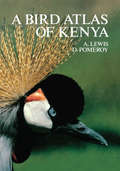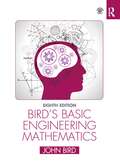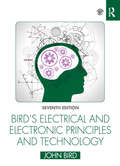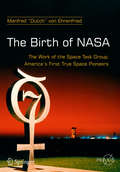- Table View
- List View
A Bird Atlas of Kenya
by Adrian LewisKenya, a country only the size of Texas, has one of the richest avifaunas in Africa. This atlas is an explanatory overview of Kenya's 1065 species, essential both to the birdwatcher as a means of finding birds and interpreting the significance of field observations, and to the ornithologist as a standard reference work.
A Bird Atlas of Kenya
by Adrian LewisKenya, a country only the size of Texas, has one of the richest avifaunas in Africa. This atlas is an explanatory overview of Kenya's 1065 species, essential both to the birdwatcher as a means of finding birds and interpreting the significance of field observations, and to the ornithologist as a standard reference work.
Bird Strike in Aviation: Statistics, Analysis and Management
by Ahmed F. El-SayedGroundbreaking Handbook Offers Detailed Research and Valuable Methodology to Address Dangerous and Costly Aviation Hazard Though annual damages from bird and bat collisions with aircraft have been estimated at $400 million in the United States and up to $1.2 billion in commercial aviation worldwide and despite numerous conferences and councils dedicated to the issue, very little has been published on this expensive and sometimes-lethal flying risk. Bird Strike in Aviation seeks to fill this gap, providing a comprehensive guide to preventing and minimizing damage caused by bird strike on aircraft. Based on a thorough and comprehensive examination of the subject, Dr. El-Sayed offers different approaches to reducing bird strikes, including detailed coverage of the three categories necessary for such reduction, namely, awareness/education, bird management (active and passive control), and aircraft design. In addition, the text discusses the importance of cooperation between airplanes, airports and air traffic authorities as well as testing methods necessary for certification of both aircraft frame and engine. Other notable features include: Statistics and analyses for bird strikes with both civil and military helicopters as well as military fixed wing aircrafts, including annual costs, critical flight altitudes, critical parts of aircraft, distance from air base and specifics of date and timing Thorough review and analysis all fatal bird strike accidents and most non-fatal accidents since 1905, the first book to provide such a reference The use of numerical methods in analyzing historic data (ex. probability functions, finite element methods for analyzing impact on aircraft structure, experimental measurement technique for displacement, vibration, component distortion, etc.) Instruction on identification of bird species (using visual, microscopic, and DNA evidence) and details of bird migration to aid air traffic control in avoiding scenarios likely to result in collision With its wealth of statistical data, innovative research, and practical suggestions, Bird Strike in Aviation will prove a vital resource for researchers, engineers and graduate students in aerospace engineering/manufacturing or ornithology, as well as for military and civilian pilots and flight crew or professionals in aviation authorities and air traffic control.
Bird Strike in Aviation: Statistics, Analysis and Management
by Ahmed F. El-SayedGroundbreaking Handbook Offers Detailed Research and Valuable Methodology to Address Dangerous and Costly Aviation Hazard Though annual damages from bird and bat collisions with aircraft have been estimated at $400 million in the United States and up to $1.2 billion in commercial aviation worldwide and despite numerous conferences and councils dedicated to the issue, very little has been published on this expensive and sometimes-lethal flying risk. Bird Strike in Aviation seeks to fill this gap, providing a comprehensive guide to preventing and minimizing damage caused by bird strike on aircraft. Based on a thorough and comprehensive examination of the subject, Dr. El-Sayed offers different approaches to reducing bird strikes, including detailed coverage of the three categories necessary for such reduction, namely, awareness/education, bird management (active and passive control), and aircraft design. In addition, the text discusses the importance of cooperation between airplanes, airports and air traffic authorities as well as testing methods necessary for certification of both aircraft frame and engine. Other notable features include: Statistics and analyses for bird strikes with both civil and military helicopters as well as military fixed wing aircrafts, including annual costs, critical flight altitudes, critical parts of aircraft, distance from air base and specifics of date and timing Thorough review and analysis all fatal bird strike accidents and most non-fatal accidents since 1905, the first book to provide such a reference The use of numerical methods in analyzing historic data (ex. probability functions, finite element methods for analyzing impact on aircraft structure, experimental measurement technique for displacement, vibration, component distortion, etc.) Instruction on identification of bird species (using visual, microscopic, and DNA evidence) and details of bird migration to aid air traffic control in avoiding scenarios likely to result in collision With its wealth of statistical data, innovative research, and practical suggestions, Bird Strike in Aviation will prove a vital resource for researchers, engineers and graduate students in aerospace engineering/manufacturing or ornithology, as well as for military and civilian pilots and flight crew or professionals in aviation authorities and air traffic control.
Birds as Monitors of Environmental Change
by J. J. D.Greenwood R. W. FurnessBirds as Monitors of Environmental Change looks at how bird populations are affected by pollutants, water quality, and other physical changes and how this scientific knowledge can help in predicting the effects of pollutants and other physical changes in the environment.
Birds as Useful Indicators of High Nature Value Farmlands: Using Species Distribution Models as a Tool for Monitoring the Health of Agro-ecosystems
by Federico Morelli Piotr TryjanowskiThis book helps to establish a simple framework to identify and use bird species as a bioindicator for high nature value (HNV) farmlands. This book focuses on suitable methods for monitoring the HNV areas, and presents the results of several case studies. The chapters put forward ways to integrate ecosystems assessment, geographical information systems (GIS) and strategies for conservation of local biodiversity. An innovative framework focuses on the use of species distribution models (SDMs) in order to explore the importance of each characteristic of HNV farmlands.Furthermore, the book examines the relationships among bird species richness, land use diversity and landscape metrics at a local scale in the farmlands.
Bird's Basic Engineering Mathematics
by John BirdNow in its eighth edition, Bird’s Basic Engineering Mathematics has helped thousands of students to succeed in their exams. Mathematical theories are explained in a straightforward manner, supported by practical engineering examples and applications to ensure that readers can relate theory to practice. Some 1,000 engineering situations/problems have been ‘flagged-up’ to help demonstrate that engineering cannot be fully understood without a good knowledge of mathematics. The extensive and thorough coverage makes this a great text for introductory level engineering courses – such as for aeronautical, construction, electrical, electronic, mechanical, manufacturing engineering and vehicle technology – including for BTEC First, National and Diploma syllabuses, City & Guilds Technician Certificate and Diploma syllabuses, and even for GCSE revision. Its companion website provides extra materials for students and lecturers, including full solutions for all 1,700 further questions, lists of essential formulae, multiple choice tests, and illustrations, as well as full solutions to revision tests for course instructors.
Bird's Basic Engineering Mathematics
by John BirdNow in its eighth edition, Bird’s Basic Engineering Mathematics has helped thousands of students to succeed in their exams. Mathematical theories are explained in a straightforward manner, supported by practical engineering examples and applications to ensure that readers can relate theory to practice. Some 1,000 engineering situations/problems have been ‘flagged-up’ to help demonstrate that engineering cannot be fully understood without a good knowledge of mathematics. The extensive and thorough coverage makes this a great text for introductory level engineering courses – such as for aeronautical, construction, electrical, electronic, mechanical, manufacturing engineering and vehicle technology – including for BTEC First, National and Diploma syllabuses, City & Guilds Technician Certificate and Diploma syllabuses, and even for GCSE revision. Its companion website provides extra materials for students and lecturers, including full solutions for all 1,700 further questions, lists of essential formulae, multiple choice tests, and illustrations, as well as full solutions to revision tests for course instructors.
Bird's Comprehensive Engineering Mathematics
by John BirdStudying engineering, whether it is mechanical, electrical or civil, relies heavily on an understanding of mathematics. This textbook clearly demonstrates the relevance of mathematical principles and shows how to apply them in real-life engineering problems. It deliberately starts at an elementary level so that students who are starting from a low knowledge base will be able to quickly get up to the level required. Students who have not studied mathematics for some time will find this an excellent refresher. Each chapter starts with the basics before gently increasing in complexity. A full outline of essential definitions, formulae, laws and procedures are introduced before real world practical situations and problem solving demonstrate how the theory is applied. Focusing on learning through practice, it contains simple explanations, supported by 1600 worked problems and over 3600 further problems contained within 384 exercises throughout the text. In addition, 35 Revision tests together with 9 Multiple-choice tests are included at regular intervals for further strengthening of knowledge. An interactive companion website provides material for students and lecturers, including detailed solutions to all 3600 further problems.
Bird's Comprehensive Engineering Mathematics
by John BirdStudying engineering, whether it is mechanical, electrical or civil, relies heavily on an understanding of mathematics. This textbook clearly demonstrates the relevance of mathematical principles and shows how to apply them in real-life engineering problems. It deliberately starts at an elementary level so that students who are starting from a low knowledge base will be able to quickly get up to the level required. Students who have not studied mathematics for some time will find this an excellent refresher. Each chapter starts with the basics before gently increasing in complexity. A full outline of essential definitions, formulae, laws and procedures is presented, before real world practical situations and problem solving demonstrate how the theory is applied. Focusing on learning through practice, it contains simple explanations, supported by 1600 worked problems and over 3600 further problems contained within 384 exercises throughout the text. In addition, 35 Revision tests together with 9 Multiple-choice tests are included at regular intervals for further strengthening of knowledge. An interactive companion website provides material for students and lecturers, including detailed solutions to all 3600 further problems.
Bird's Electrical and Electronic Principles and Technology
by John BirdNow in its seventh edition, Bird’s Electrical and Electronic Principles and Technology introduces and covers theory through detailed examples and laboratory experiments, enabling students to gain knowledge required by technicians in fields such as engineering, electronics, and telecommunications. This edition includes several new sections, including glass batteries, climate change, the future of electricity production, and discussions concerning everyday aspects of electricity, such as watts and lumens, electrical safety, AC vs DC, and trending technologies. The extensive and thorough topic coverage makes this a great text for a range of level 2 and 3 engineering courses, which has helped thousands of students succeed in their exams. It is also suitable for BTEC First, National and Diploma syllabuses, City & Guilds Technician Certificate and Diploma syllabuses, and Foundation Degrees in engineering. Its companion website at www.routledge.com/cw/bird provides resources for both students and lecturers, including full solutions for all 900 further questions, lists of essential formulae, multiple-choice tests and illustrations, as well as full solutions to revision tests and lab experiments for course instructors.
Bird's Electrical and Electronic Principles and Technology
by John BirdNow in its seventh edition, Bird’s Electrical and Electronic Principles and Technology introduces and covers theory through detailed examples and laboratory experiments, enabling students to gain knowledge required by technicians in fields such as engineering, electronics, and telecommunications. This edition includes several new sections, including glass batteries, climate change, the future of electricity production, and discussions concerning everyday aspects of electricity, such as watts and lumens, electrical safety, AC vs DC, and trending technologies. The extensive and thorough topic coverage makes this a great text for a range of level 2 and 3 engineering courses, which has helped thousands of students succeed in their exams. It is also suitable for BTEC First, National and Diploma syllabuses, City & Guilds Technician Certificate and Diploma syllabuses, and Foundation Degrees in engineering. Its companion website at www.routledge.com/cw/bird provides resources for both students and lecturers, including full solutions for all 900 further questions, lists of essential formulae, multiple-choice tests and illustrations, as well as full solutions to revision tests and lab experiments for course instructors.
Bird's Electrical Circuit Theory and Technology
by John BirdNow in its seventh edition, Bird’s Electrical Circuit Theory and Technology explains electrical circuit theory and associated technology topics in a straightforward manner, supported by practical engineering examples and applications to ensure that readers can relate theory to practice. The extensive and thorough coverage, containing over 800 worked examples, makes this an excellent text for a range of courses, in particular for Degree and Foundation Degree in electrical principles, circuit theory, telecommunications, and electrical technology. The text includes some essential mathematics revision, together with all the essential electrical and electronic principles for BTEC National and Diploma syllabuses and City & Guilds Technician Certificate and Diploma syllabuses in engineering. This material will be a great revision for those on higher courses. This edition includes several new sections, including glass batteries, climate change, the future of electricity production, and discussions concerning everyday aspects of electricity, such as watts and lumens, electrical safety, AC vs DC, and trending technologies. Its companion website at www.routledge.com/cw/bird provides resources for both students and lecturers, including full solutions for all 1400 further questions, multiple choice questions, lists of essential formulae and bios of famous engineers; as well as full solutions to revision tests, lab experiments, and illustrations for adopting course instructors.
Bird's Electrical Circuit Theory and Technology
by John BirdNow in its seventh edition, Bird’s Electrical Circuit Theory and Technology explains electrical circuit theory and associated technology topics in a straightforward manner, supported by practical engineering examples and applications to ensure that readers can relate theory to practice. The extensive and thorough coverage, containing over 800 worked examples, makes this an excellent text for a range of courses, in particular for Degree and Foundation Degree in electrical principles, circuit theory, telecommunications, and electrical technology. The text includes some essential mathematics revision, together with all the essential electrical and electronic principles for BTEC National and Diploma syllabuses and City & Guilds Technician Certificate and Diploma syllabuses in engineering. This material will be a great revision for those on higher courses. This edition includes several new sections, including glass batteries, climate change, the future of electricity production, and discussions concerning everyday aspects of electricity, such as watts and lumens, electrical safety, AC vs DC, and trending technologies. Its companion website at www.routledge.com/cw/bird provides resources for both students and lecturers, including full solutions for all 1400 further questions, multiple choice questions, lists of essential formulae and bios of famous engineers; as well as full solutions to revision tests, lab experiments, and illustrations for adopting course instructors.
Bird's Engineering Mathematics
by John BirdNow in its ninth edition, Bird’s Engineering Mathematics has helped thousands of students to succeed in their exams. Mathematical theories are explained in a straightforward manner, supported by practical engineering examples and applications to ensure that readers can relate theory to practice. Some 1,300 engineering situations/problems have been ‘flagged-up’ to help demonstrate that engineering cannot be fully understood without a good knowledge of mathematics. The extensive and thorough topic coverage makes this a great text for a range of level 2 and 3 engineering courses – such as for aeronautical, construction, electrical, electronic, mechanical, manufacturing engineering and vehicle technology – including for BTEC First, National and Diploma syllabuses, City & Guilds Technician Certificate and Diploma syllabuses, and even for GCSE and A-level revision. Its companion website at www.routledge.com/cw/bird provides resources for both students and lecturers, including full solutions for all 2,000 further questions, lists of essential formulae, multiple-choice tests, and illustrations, as well as full solutions to revision tests for course instructors.
Bird's Engineering Mathematics
by John BirdNow in its ninth edition, Bird’s Engineering Mathematics has helped thousands of students to succeed in their exams. Mathematical theories are explained in a straightforward manner, supported by practical engineering examples and applications to ensure that readers can relate theory to practice. Some 1,300 engineering situations/problems have been ‘flagged-up’ to help demonstrate that engineering cannot be fully understood without a good knowledge of mathematics. The extensive and thorough topic coverage makes this a great text for a range of level 2 and 3 engineering courses – such as for aeronautical, construction, electrical, electronic, mechanical, manufacturing engineering and vehicle technology – including for BTEC First, National and Diploma syllabuses, City & Guilds Technician Certificate and Diploma syllabuses, and even for GCSE and A-level revision. Its companion website at www.routledge.com/cw/bird provides resources for both students and lecturers, including full solutions for all 2,000 further questions, lists of essential formulae, multiple-choice tests, and illustrations, as well as full solutions to revision tests for course instructors.
Bird's Higher Engineering Mathematics
by John BirdHigher Engineering Mathematics has helped thousands of students to succeed in their exams by developing problem-solving skills, It is supported by over 600 practical engineering examples and applications which relate theory to practice. The extensive and thorough topic coverage makes this a solid text for undergraduate and upper-level vocational courses. Its companion website provides resources for both students and lecturers, including lists of essential formulae, ands full solutions to all 2,000 further questions contained in the 277 practice exercises; and illustrations and answers to revision tests for adopting course instructors.
Bird's Higher Engineering Mathematics
by John BirdNow in its ninth edition, Bird’s Higher Engineering Mathematics has helped thousands of students to succeed in their exams. Mathematical theories are explained in a straightforward manner, supported by practical engineering examples and applications to ensure that readers can relate theory to practice. Some 1,200 engineering situations/problems have been ‘flagged-up’ to help demonstrate that engineering cannot be fully understood without a good knowledge of mathematics. The extensive and thorough topic coverage makes this an ideal text for undergraduate degree courses, foundation degrees, and for higher-level vocational courses such as Higher National Certificate and Diploma courses in engineering disciplines. Its companion website at www.routledge.com/cw/bird provides resources for both students and lecturers, including full solutions for all 2,100 further questions, lists of essential formulae, multiple-choice tests, and illustrations, as well as full solutions to revision tests for course instructors.
The Birth of an Indian Profession: Engineers, Industry, and the State, 1900–47
by Aparajith RamnathThe Birth of an Indian Profession is the first comprehensive history of engineers in modern India. Charting the development of the engineering profession in the country from 1900 to 1947, it explores how engineers, their roles, and their organization were transformed during the politically tumultuous interwar years. Through detailed case studies of engineers in public works, railways, and private industry, the book argues that the profession, once dominated by expatriate British engineers closely associated with the state, saw an increasing proportion of Indian members, and an emerging emphasis on industrial engineering. In the process, it fashioned for itself an Indian identity. Turning the spotlight on practitioners of technology and their professional lives, Ramnath explores several themes including the work culture of engineers, their conception of their own identity, their status in society, and their relationship with the evolving colonial state. In so doing, he provides a fresh perspective on the history of science and technology in twentieth-century India.
The Birth of NASA: The Work of the Space Task Group, America's First True Space Pioneers (Springer Praxis Books)
by Dutch Von EhrenfriedThis is the story of the work of the original NASA space pioneers; men and women who were suddenly organized in 1958 from the then National Advisory Committee on Aeronautics (NACA) into the Space Task Group. A relatively small group, they developed the initial mission concept plans and procedures for the U. S. space program. Then they boldly built hardware and facilities to accomplish those missions. The group existed only three years before they were transferred to the Manned Spacecraft Center in Houston, Texas, in 1962, but their organization left a large mark on what would follow.Von Ehrenfried's personal experience with the STG at Langley uniquely positions him to describe the way the group was structured and how it reacted to the new demands of a post-Sputnik era. He artfully analyzes how the growing space program was managed and what techniques enabled it to develop so quickly from an operations perspective. The result is a fascinating window into history, amply backed up by first person documentation and interviews.
Birth of the Shinkansen: The Origin Story of the World-First Bullet Train
by Tetsuo ShimomaeThis book discusses the Shinkansen, the world's first high-speed railway, which was born in Japan in 1964 and how it has developed up to the present day. In the 1950s, some European railways were trying to increase the commercial operating speed up to 160 km/h, and it was considered difficult to raise it to 200 km/h. Japanese engineers with excellent engineering ability post World War ll moved from the military to the railways to overcome the technological challenges realizing the high-speed railways using new approaches. The book discusses the technological barriers in speeding up the railway at that time and how these engineers overcame them in non-computer days. In the five decades since the Shinkansen began operating, there have been significant developments enabling high-speed, safe, and frequent train operation with high punctuality while conserving the environment. The book also describes today’s highly evolved Shinkansen. The Shinkansen, which runs 440,000 km a day, has carried 13.3 billion people without a single fatality in 56 years. The book overviews factors that contributed to the Shinkansen’s high safety record. This book is an excellent guide for those interested in the history of the world’s first high-speed railway.
Biscuit Manufacture: fundamentals of in-line production
by P. R. WhitelyTHE intention of this book is to provide a guide for potential management and supervisors and for those who wish to understand the fundamental principles of biscuit manufacture. It does not set out to be a learned treatise. The purpose of the book is to simplify and explain processes and materials so that the 'mystique'is replaced by logic. Once the mystique is removed the biscuit maker is one step closer to anticipating and solving problems. In attempting to cover this subject within one concise volume, it is difficult to avoid over-simplification or generalisation, and apologies must be offered in advance where these occur. To wallow in the fine details of specialisation is to defeat the object of the book, and less would be achieved if the issues were confused. The reader's attention is drawn to the interpretation of formulae (recipes). Raw materials, equipment, methods, processes, and conditions vary considerably; the formulae are intended as blue prints from which, with a knowledge of the materials and aims of the processes, and by trial and error, a biscuit can be produced bearing some semblance to the original. All formulae should be interpreted in conjunction with the 'Guide to using formulae' at the beginning of Chapter 12. As the biscuit industry advances towards complete automation, plant and equipment become more advanced and sophisticated.

















